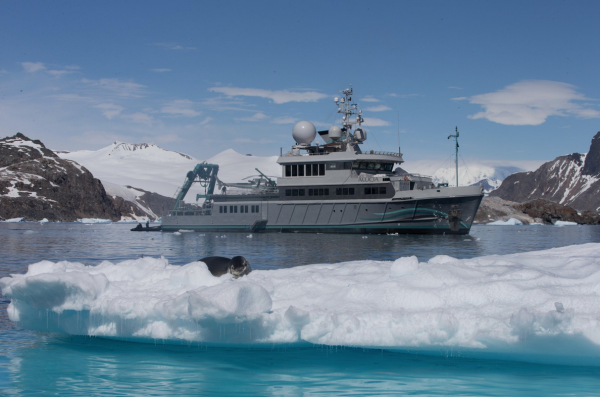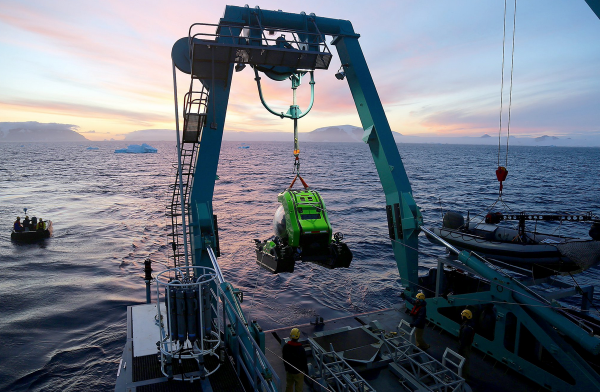M/V Alucia and Blue Planet II
Exclusive insight into the filming of the BBC series ‘Blue Planet II’ aboard the research vessel 'Alucia'…
Blue Planet II fever has officially swept the nation. The documentary series, which has aired in the UK each Sunday night for the past few weeks, transfixed its audience. Narrated by Sir David Attenborough, the episodes have focused on life in our oceans, travelling the globe to capture remarkable natural wonders and animal behaviours, from giant tidal waves in Portugal to a pilot whale’s devastating encounter with plastic pollution.
For those within the superyacht industry, there may have been a few familiar sights in various episodes. Firstly, a Triton submersible (named Nadir), which enabled Attenborough to visit the depths of the ocean and M/V Alucia, the 56m research vessel owned by Ray Dalio (built in the 1970s as a French support vessel). Speaking exclusively to SuperyachtNews, Alex Flemming, co-CEO of marine operations for Alucia, explains how the collaboration with the BBC came to fruition. “We are trying to make underwater exploration interesting and fun, so that it makes a difference. Not only pushing the project and the idea of conservation, but also make people aware of what is going on,” he begins.
The aim of the series, and of the Alucia team, is to raise awareness about the current situation in our oceans. “70 per cent of our planet is ocean, and we only know about 15 per cent of it, how does that make sense? We’re spending more money trying to populate the moon, than we are in our ocean backyard,” says Flemming, Speaking further on the partnership with the BBC, who have worked with Alucia on Blue Planet II and Attenborough's Great Barrier Reef, Flemming explains that their relationship is due to Alucia’s expedition capabilities, and the autonomy that the ship allows the documentary film crew. “The BBC wanted to access parts of the world never discovered before, and due to the capability of Alucia and her arsenal of tricks, they were able to bring amazing never-seen-before footage to TV screens around the world.” The expeditions travelled across the globe, enabling the team on board to capture the first ever recorded sighting of a Giant Squid, off of the coast of Japan.
“The BBC wanted to access parts of the world never discovered before, and due to the capability of Alucia and her arsenal of tricks, they were able to bring amazing never-seen-before footage to TV screens around the world.”
In addition to the footage broadcast by the BBC, Alucia has her own media wing: Alucia Productions. Using state-of-the-art equipment to produce short films and documentaries about the ship’s expeditions, this is another channel that the ship is using to publicise its findings and journeys. “On top of the scientific support, the Alucia project has an extra angle, which is the media,” offers Flemming. Those behind the camera lens are dedicated to using this platform to educate a wider audience about the scientific discoveries found by researchers. By creating these powerful, yet easy-to-digest video snippets, the work of Alucia reaches a much larger group of people than academic papers or articles in scientific journals. As Flemming explains: “It is all very well sponsoring the science, but the important thing is that the results from the scientific missions don’t just become a thesis that nobody hears about, which is unfortunately what happens to a lot of scientific papers due to pressures on the scientific community to secure their next grant. They may circulate within that community but the word never gets out to the rest of the world.”
For Flemming and the Alucia team, the expeditions and resulting media coverage are a hugely important part of the process, in addition to the research carried out on the vessel. “It’s very important that [Alucia’s] discoveries and work have an impact, and that impact might be as simple as encouraging the next generation to become scientists, and to keep pushing the frontiers to find solutions to the sustainability of the planet.” The Blue Planet II footage struck the ideal balance of educating and entertaining, whilst also hitting home the catastrophic impact of global warming, plastic in the oceans and marine environments dying out due to human behaviour. The shocking scenes of ocean pollution, for example, have contributed to a nationwide conversation about the state of our seas. Indeed, it’s this ‘first-hand’ experience of conservation that encouraged Dalio to buy Alucia. According to Flemming, he was inspired to purchase the vessel (he hadn’t previously owned a yacht) after seeing the work of Woods Hole Oceanographic Institute –an independent research facility who also work with Eric and Wendy Schmidt’s foundation, which prompted him to become more actively involved in their work for ocean conservation.
The Blue Planet II footage struck the ideal balance of educating and entertaining, whilst also hitting home the catastrophic impact of global warming, plastic in the oceans and marine environments dying out due to human behaviour. The shocking scenes of ocean pollution, for example, have contributed to a nation-wide conversation about the state of our seas.
Speaking on the role of individual yacht owners in ocean conservation, Flemming highlights the importance that the platform a yacht can offer the scientific and philanthropic community. As evident in the Research Expedition Vessel (REV) project, there are a number of owners who are taking it upon themselves to drive forward research in a direct way. “It’s giving back to the world by allowing access to places where people couldn’t have done before. Giving back more than just a charitable donation... this is about opening another avenue that high net worth’s can take, to aid NGOs to get access to the planet and do their work.” The more owners who adopt this mentality, the better. As Attenborough bluntly stated in the final episode, which aired last week, “The oceans are under threat now, as never before in human history.”
Read more about research and expedition vessels in the next issue of The Superyacht Report. Click here to see if you are eligible for a complimentary subscription.
Image one: courtesy of Alucia Productions/BBC Earth
Image two: copyright James Honeyborne, BBC NHU '17
55.75m 11.90m 4.95m 1400
Joseph Artese Design
Ateliers et Chantiers C. Auroux
NEW: Sign up for SuperyachtNewsweek!
Get the latest weekly news, in-depth reports, intelligence, and strategic insights, delivered directly from The Superyacht Group's editors and market analysts.
Stay at the forefront of the superyacht industry with SuperyachtNewsweek
Click here to become part of The Superyacht Group community, and join us in our mission to make this industry accessible to all, and prosperous for the long-term. We are offering access to the superyacht industry’s most comprehensive and longstanding archive of business-critical information, as well as a comprehensive, real-time superyacht fleet database, for just £10 per month, because we are One Industry with One Mission. Sign up here.
NEW: Sign up for
SuperyachtNewsweek!
Get the latest weekly news, in-depth reports, intelligence, and strategic insights, delivered directly from The Superyacht Group's editors and market analysts.
Stay at the forefront of the superyacht industry with SuperyachtNewsweek





